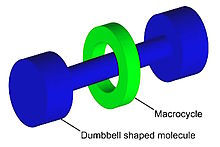
Back الروتاكسان Arabic রোটাক্সেন Bengali/Bangla Rotaxà Catalan Rotaxany Czech Rotaxane German Rotaxano Spanish Rotaksaanit Finnish Rotaxane French Rotaxano Italian ロタキサン Japanese


A rotaxane (from Latin rota 'wheel' and axis 'axle') is a mechanically interlocked molecular architecture consisting of a dumbbell-shaped molecule which is threaded through a macrocycle (see graphical representation). The two components of a rotaxane are kinetically trapped since the ends of the dumbbell (often called stoppers) are larger than the internal diameter of the ring and prevent dissociation (unthreading) of the components since this would require significant distortion of the covalent bonds.
Much of the research concerning rotaxanes and other mechanically interlocked molecular architectures, such as catenanes, has been focused on their efficient synthesis or their utilization as artificial molecular machines. However, examples of rotaxane substructure have been found in naturally occurring peptides, including: cystine knot peptides, cyclotides or lasso-peptides such as microcin J25.
- ^ Bravo, José A.; Raymo, Françisco M.; Stoddart, J. Fraser; White, Andrew J. P.; Williams, David J. (1998). "High Yielding Template-Directed Syntheses of [2]Rotaxanes". Eur. J. Org. Chem. 1998 (11): 2565–2571. doi:10.1002/(SICI)1099-0690(199811)1998:11<2565::AID-EJOC2565>3.0.CO;2-8.